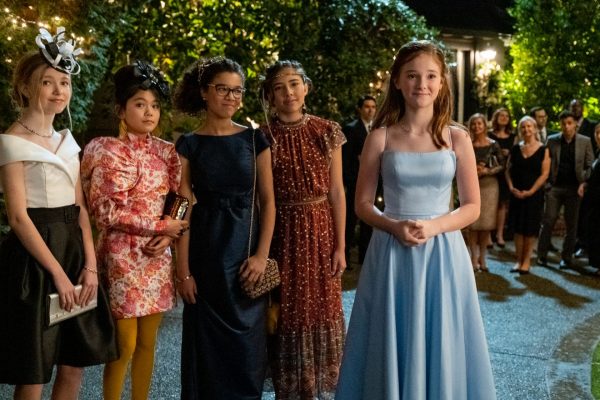Television Review: Delightfully Revived “Baby-Sitters Club” — More Than ’90s Nostalgia
By Sarah Osman
During a period when we are facing a ferocious pandemic, the biggest Civil Rights movement since the ’60s, and the possibility of flying snakes, it is the perfect time to remake the cheery Baby-Sitters Club.

Netflix’s new series The Baby-Sitters Club is based on the bestselling book series about middle schoolers who start their babysitting business in the town of Stoneybrook, CT. Here the club attends a wedding. Photo: Liane Hentscher/ Netflix.
In the mid ’90s, my sister became obsessed with a series of popular books written by Ann M. Martin (and later TV series and film) by the name of The Baby-Sitters Club. She was drawn to Kristy in particular, the president and bossiest member of the group (probably because my sister likes to be in charge and is bossy by nature). As the younger sibling, I gravitated toward anything my sister liked, and in turn, began to read the books and watched the film. I enjoyed the characters’ simple problems and that, by the end of the book, most of their obstacles were overcome. Topics dealt with ranged from the sensitive, illness and divorce, to the lighthearted, such as first crushes. I hadn’t thought about the series after I had initially taken in the adventures of Kristy, Claudia, Stacy, and Mary Anne — until I saw that Netflix was revitalizing the series.
During a time when we are facing a ferocious pandemic, the biggest Civil Rights movement since the ’60s, and the possibility of flying snakes, it is the perfect time to remake the cheery Baby-Sitters Club. But to be successful, it would have to pull off a double somersault: Could the show both provide the pleasures of nostalgia and attract a new audience? If not, the series could end up being a cheap knockoff (or worse, a gritty, realpolitik reimagining).
Thankfully, the 2020 iteration of The Baby-Sitters Club is as charming (for multiple generations) as its predecessor. The premise is elemental: Kristy (Sophie Grace) is a middle schooler who, after seeing her mother (a welcome Alicia Silverstone) scramble for a babysitter, decides to start a business that with one phone call would connect parents with a group of four middle school baby-sitters, thus forming The Baby-Sitters Club.
The series has been carefully cast. Kristy (Sophie Grace) is as bossy and tenacious as she was in the books; Claudia (Momona Tamada) is artsy and fashionable, stuck being an outcast in her own family; Stacey (Shay Rudolph) is sophisticated and insecure, while Mary-Anne (Malia Baker) is now written as mixed-race and saddled with an overprotective father, and there’s Dawn (Xochitl Gomez), a worldly newcomer from California. The kid performers blend well together, interacting with each other as 13-year-old girls should. The only major drawback is the writing, which at times has the girls talk in a manner that is far more refined than what would come out of the mouth of your average middle schooler. In this sense, the series stumbles into the pitfall that besets most teen soaps: kids behave and act as adults would.
Thankfully, this flaw never becomes severe. While the characters sometimes sound wise beyond their years, how they deal with their challenges are not. The kids face the same problems their novelist counterparts did. Claudia struggles to fit in with her family, who want her to bring home great grades when all she wants to do is create art. Mary Anne tries to overcome her shy nature. Kristy has to learn how to accept her new stepfather, and Stacey needs to come to term with her diabetes. These aren’t major traumas or wild mysteries; they may seem small in the grand scheme of things. But for these middle schoolers they are significant milestones — just as they would be for real-life kids.
The plots may be simple, but they tackle complex topics. The series covers economic inequality, transgender kids, the struggle of being mixed race, and the growing obstacles in today’s world of caring for children. Quite a few teen shows focus on these story lines via over-the-top confrontations, ranging from murder to sex to drugs. It’s refreshing to find a show that doesn’t turn to these hysterical devices to make serious points about surviving as an adolescent.
2020’s The Baby-Sitters Club has also been cleverly updated. The characters use social media, face online bullying, and create playlists for each other. Kristy’s older brothers play guitar and video games. Still, amid the modern technology, there are comforting nods to the original series. The characters take calls via a landline phone and Kristy dresses like a ’90s grunge skater. In the books, Claudia was the only ethnically diverse character (Japanese), but the show, thankfully, has now become a more truthful reflection of the diverse world we live in.
There are critics who will write the series off as being only for girls. But there is far more going on here than that. The Baby-Sitters Club is the kind of good-natured cultural reflection that educates: it is a nuanced and intelligent look at what it means to be a young woman in America today. The admirable spirit of the ’90s books lives on — fans old and new are sure to be delighted.
Sarah Mina Osman is a writer living in Los Angeles. She has written for Young Hollywood and High Voltage Magazine. She will be featured in the upcoming anthology Fury: Women’s Lived Experiences under the Trump Era.

